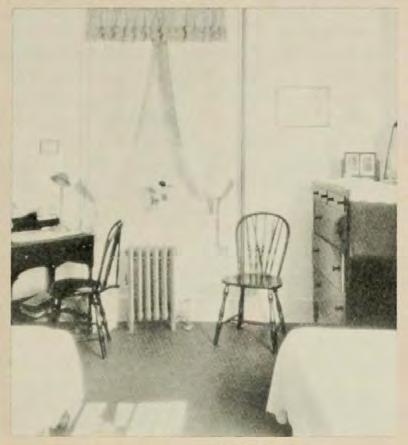
42 minute read
College News
C A M P U S & C O M M U N I T Y N E W S
The Board of Trustees approved a new test optional admissions policy on February 1. This means firstyear applicants seeking admission to the College beginning in the fall of 2021 may choose whether or not to provide standardized testing (SAT or ACT scores) as part of the admission application process. The Board also announced a freeze in tuition, fees, and room and board costs for the 2020-2021 academic year. The decision was made after a review of recommendations from a Board of Trustees Task Force, formed in 2019 at the request of President Tuajuanda C. Jordan. The Task Force studied how the College, as a public institution that is focused on providing an outstanding education, could ensure greater access to students. The effect of a one-year freeze is significant, resulting in approximately $3,000 in savings for an in-state student over the course of four years, and more than $4,000 in savings for an out-of-state student.
The Board of Trustees of St. Mary’s College of Maryland approved a proposal to develop and implement new varsity men’s and women’s track and field programs. The decision was made after a review of recommendations from a Board of Trustees Task Force, formed in 2019 at the request of President Tuajuanda C. Jordan. Modifications to the current track begin this summer to make the surface compliant with NCAA regulations. The track is expected to be ready for varsity competition to begin fall 2020. The varsity field programs will roll out at a later date. A $400,000 gift to the College’s Foundation by William Seale is being used for the track renovations. Seale is a member of the St. Mary’s College of Maryland Board of Trustees and a former member of the SMCM Foundation Board of Directors.
On April 3, in response to the COVID-19 crisis, the Board of Trustees approved a mechanism for reimbursement of room and board that will reflect the prorated charges for room, board, mandatory fees, and parking, to cover the period of March 23 through the end of the semester.
Associate Professor of Biology Kevin Emerson jump-started a campus-wide initiative at St. Mary’s College of Maryland to provide the St. Mary’s County Health Department with essential supplies for medical personnel working the front lines to care for those infected with COVID-19, and to help stem the spread of the disease. Emerson solicited donations from the biology, chemistry, and physics academic departments, as well as the athletics department and The Wellness Center, which, in turn, provided to the health department approximately 8,000 protective gloves, 50 exam gowns, 100 surgical masks, 50 n95 masks, 500 alcohol swabs, and 15 bottles of hand sanitizer.
St. Mary’s College of Maryland’s Office of Institutional Advancement, led by Vice President Carolyn Curry, won four awards in the 35 th Annual Educational Advertising Awards sponsored by Higher Education Marketing Report. Hawktoberfest earned a silver award in the Special Event category and Giving Tuesday earned a bronze award in the Fund-Raising Campaign category. Two awards were submitted on behalf of St. Mary’s College by its marketing agency Creative Communication Associates. Under the category of Total Recruitment Package – including the College’s viewbook, travel piece and LEAD brochure – a silver award was earned. A silver award was also earned for the Fall Open House Campaign. Additionally, in the Collegiate Advertising Awards, the Apply Now postcard series earned a gold award and the admittance packet pocket folder earned a silver award.
PRESIDENT’S NEWS
St. Mary’s College of Maryland has been named to the 2020-21 cohort of First-gen Forward Institutions by The Center for First-generation Student Success, an initiative of NASPA – Student Affairs Administrators in Higher Education and The Suder Foundation.
The First-gen Forward designation recognizes institutions of higher education who have demonstrated a commitment to improving experiences and advancing outcomes of first-generation college students. “The Center is so pleased to welcome St. Mary’s College into the 2020-21 cohort of First-gen Forward institutions. Through the

application process, it was evident that St. Mary’s College is not only taking steps to serve first-generation students but is prepared to make a long-term commitment and employ strategies for significant scaling and important advances in the future,” said Sarah E. Whitley, senior director of the Center for First-generation Student Success.
President Tujuanda C. Jordan with poets Naomi Shihab Nye and Danusha Lameréris. Nye and Lameéris read original works during the “Nurturing the Compassion Community: An Evening to Honor the Legacy of Lucille Clifton” on February 29.

The Office of the President presented “Nurturing the Compassionate Community: An Evening to Honor the Legacy of Lucille Clifton” on February 29. The event was co-sponsored by the VOICES Reading Series and featured poetry readings and reflections to honor St. Mary’s College’s former Distinguished Professor of the Humanities Lucille Clifton. Naomi Shihab Nye and Danusha Laméris performed original works of poetry during the event. Nye is the author of numerous books of poems, including “The Tiny Journalist” (BOA Editions, 2019); “Voices in the Air: Poems for Listeners” (Greenwillow Books, 2018); “Transfer” (BOA Editions, 2011); “You and Yours” (BOA Editions, 2005), which received the Isabella Gardner Poetry Award; and “19 Varieties of Gazelle: Poems of the Middle East” (Greenwillow Books, 2002), a collection of new and selected poems about the Middle East.
Danusha Laméris’s first book of poems, “The Moons of August” (2014), won the 2013 Autumn House Press poetry contest. She was born in Massachusetts and raised in California. She earned a bachelor’s degree in fine arts at University of California, Santa Cruz and studied at the Squaw Valley Writers Workshops and with the poet Ellen Bass. Lee Capristo, director of publications, and Janna Thompson, assistant professor of educational studies, both received the President’s Lucille Clifton Award. Nominated by senior students, faculty and staff of the College, the President’s Lucille Clifton Award is given to employees who best embody the spirit of caring, compassion and nurturing that characterized Lucille Clifton’s tenure at the College.
FACULTY, STAFF & STUDENT NEWS
Professor of History Christine Adams’ new book, “The Creation of the French Royal Mistress: From Agnès Sorel to Madame Du Barry,” (2020, Penn State University Press) is now available. Her current book is co-authored by her sister Tracy Adams, professor of French in the School of Cultures, Languages and Linguistics at the University of Auckland, New Zealand. Ivy Antunes ’20 and Nhu Chau ’20 were recently admitted into the American Society for Biochemistry and Molecular Biology (ASBMB) Honor Society. ASBMB selects students who demonstrate exceptional achievement in academics, undergraduate research, and science outreach.
Betül Başaran, professor of religious studies, was awarded a Fulbright Global Scholars Award for research during spring 2021 in England and India. She will be doing research for a book project on the legacy and impact of Princess Niloufer (1916- 1989), who was condemned with the rest of the Ottoman dynasty to life-long exile in 1924 following the collapse of the Ottoman Empire. Başaran was a Folger Institute Fellow during 2018-19 in Washington, D.C. Adriana Brodsky, associate professor of history, was awarded a summer stipend of $6,000 from the National Endowment for the Humanities to complete the booklength monograph titled “Jewish Argentine Youth, 1940-1976.” As Jews were persecuted and murdered in Europe, Argentine Jews looked to the youth for salvation. This manuscript traces how Argentine Jewish youth responded to that and other calls to action as they lived through defining global and local moments. Through their responses, Argentine Jewish Youth played a central role in modernizing their community(ies) in Argentina, and in shaping ethnic identities both in Argentina and in Israel. Brodsky did research for the project in Israel on a Fulbright Senior Scholar award in 2018. Professor of Biology Jeffrey Byrd published “Guidelines for Biosafety in Teaching Laboratories Version 2.0: A Revised and Updated Manual for 2019” in the Journal of Microbiology & Biology Education, along with colleagues Elizabeth Emmer of Salisbury University, Robert Maxwell of Georgia State University, and Heather Townsend of Rhode Island Community College. Byrd, who serves as the safety editor for that journal, said prior to 2012 there weren’t any concrete biosafety guidelines for teaching laboratories as there have been for research labs. Byrd was on the ASM Task Committee that developed the original guidelines and chaired the committee for the revised version. Emily Casey, assistant professor of art history, has been selected to participate in the Attingham Trust’s Royal Collection Studies course in London this fall. The course focuses on the collections of Britain’s monarchies from the sixteenth century through the present. Casey’s participation will contribute to her current research on the role of visual culture in propagating and supporting the aims of empire in the early modern Atlantic World. She received a scholarship from the American Friends of Attingham to support her participation.
Baylor University in Waco, Texas, has named Jennifer CognardBlack, professor of English at St. Mary’s College of Maryland, the 2020 recipient of its Robert Foster Cherry Award for Great Teaching. Awarded biennially, The Cherry Award is a prestigious national teaching award – with the single, largest monetary reward of $250,000 presented by a college or university to an individual for exceptional teaching. The award program is designed to honor great teachers, stimulate discussion in the academy about the value of teaching and encourage departments and institutions to recognize their own great teachers. See more on Jennifer Cognard-Black on p. 12. Karen Crawford, professor of biology, has been awarded a Whitman Fellowship from the Marine Biological Laboratory. The award will be used to cover laboratory space and housing at MBL in Woods Hole, Massachusetts. Crawford is using the award to continue her sabbatical research project investigating the use of CRISPR-Cas9 genome editing to knockout specific gene functions in developing embryos.
Todd Eberly, professor of political science and public policy, has a new book. “How Trump Happened: A System Shock Decades in the Making” (Rowman & Littlefield Publishers, March 2020), focuses on the 2016 election of President Donald Trump, but is also relevant to the current democratic primary and why Senator Bernie Sanders again failed to win the nomination.
Jeff Eden, assistant professor of history, was interviewed in March on Radio Free Asia - Uyghur for his recent book, “Warrior Saints of the Silk Road.” A recent review of the book in the Journal of Asian Studies concluded that the book “will surely become required reading for those who work on Central Asian history, hagiography, or Uyghur studies.”
Kevin Emerson, associate professor of biology, was published in Parasites and Vectors journal. In the article, Emerson and colleagues show that there is variation in traits associated with malaria transmission and biome-of-origin, temperature, and family genetics. These are important factors to be considered for future mosquito control strategies.
Misty Frantz and Kate Shirey of the Career Development Center will present a workshop at this year’s NACE conference, taking place in Minneapolis, Minnesota, in June. The focus of their interactive workshop, “The Real Problem with Career Services,” will explore the model St. Mary’s College has adopted to incorporate career readiness into the liberal arts while highlighting necessary tools for other institutions to develop an equitable system of career readiness within the college experience.
Professor of Music David Froom’s clarinet concerto, “Canzoni di Notte” won first prize at the Riverside Symphony’s National Composers Competition. As the winner, this work receives its premiere performance in Alice Tully Hall (New York City), conducted by George Rothman and featuring clarinet soloist Narek Arutyunian.
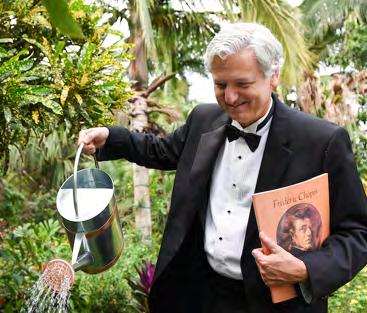
Musician-in-Residence Brian Ganz kicked off the spring semester’s musical offerings on January 23 with an all-Chopin recital on the theme of Musical Gardening. The recital was a preview of the next installment of his years-long “Extreme Chopin” series at the Music Center at Strathmore, located in Bethesda, Maryland. Liza Gijanto, associate professor of anthropology, recently published an article in The International Journal of Historical Archaeology. “Interpreting West Ashcom: Drones, Artifacts, and Archives,” is based on work at Cremona Estate in Mechanicsville, Maryland, and draws on field work completed by St. Mary’s College students as part of archaeology field schools in 2016 and 2018, as well as students from the anthropology department’s Research Methods course. Cassie Gurbisz, assistant professor of environmental studies, received her second grant from the National Oceanic and Atmospheric Administration Maryland Sea Grant program. The $71,023 grant will fund a two-year project titled “Effects of Oyster Aquaculture on Submersed Aquatic Vegetation (SAV) Habitat.” Gurbisz is a coastal ecosystem ecologist who takes a holistic approach to studying the environment. Her research has been published in journals such as BioScience and Proceedings of the National Academy of Sciences, as well as recently featured in the Baltimore Sun.
The annual Reeves Lecture with Jeffrey Hammond, professor of English and George B. and Willma Reeves Distinguished Professor in the Liberal Arts, took place on February 12. “The Snow Woman: Some Reflections on Masculinity, Morality, and Art,” comes from a memory of a not-so-innocent childhood incident which prompts Professor Hammond to meditate on the insistently male-centered bias of the Western artistic tradition. By tracing the story of Pygmalion and his statue as it came down from the ancient Roman poet Ovid through medieval and early modern times, he reflects on the story as an example of art’s capacity to establish and reinforce inequities of power relating to gender.
Angela Johnson, professor of educational studies, has been awarded a $103,473 grant from the National Science Foundation in support of her project titled: “Centering Women of Color in STEM: Data-Driven Opportunities for Inclusion.” The two-year grant began in September 2019, and will fund a continuation of Johnson’s collaborative research with Apriel Hodari of Eureka Scientific, Inc. to identify and share what helps women of color thrive in science, technology, engineering and mathematics (STEM) fields. Johnson and Hodari have worked with SMCM students Rose Young ’20 and Elizabeth Mulvey ’20 to conduct and analyze interviews with faculty, staff, and students at SMCM and two United Kingdom institutions. Results were shared at the winter meeting of the American Association of Physics Teachers in January 2020.
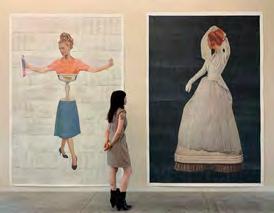
Sue Johnson, professor of art, is one of 10 artists who have been awarded a VMFA Visual Arts Fellowship in the professional category for 2020-21. This is an $8,000 award to be used by the artist to support their creative practice, and also includes opportunities for fellowship recipients to exhibit their work at the Virginia Museum of Fine Arts and other museum sites. She also has recently been awarded a fullyfunded residency fellowship by The Millay Colony for the Arts in upstate New York. Johnson is one of only 30 visual artists, composers, and writers selected from more than 800 international applicants for this highly competitive fellowship. She will be in residence for the month of June 2020 during which time she will continue work on her project, “Hall of Portraits from The History of Machines.” Works completed during the residency will be part of Johnson’s upcoming one-person exhibition at VisArts in Rockville, Maryland, opening in September 2020. Katherine Koch, associate professor of educational studies, has published a new textbook titled “EMS Response to Patients with Special Needs: Assessment, Treatment, and Transport” (Fire Engineering). The textbook is the first comprehensive resource of its kind to address the emergency prehospital needs of people with disabilities. Koch is currently working on an audiobook version as well as instructor materials for potential courses associated with the text.
Associate Professor of Mathematics Emek Köse has been appointed chair of the student chapters committee of the Association of Women in Mathematics (AWM.) Her two-year term began in February. The AWM is a leading society for women in the mathematical sciences and is one of the societies comprising the Conference Board of the Mathematical Sciences. David Kung, professor of mathematics, teamed up with The Great Courses to host a new video that helps explain the disease spread of the novel coronavirus, SARSCoV-2. The 15-minute program is called “How Math Predicts the Coronavirus Curve.” Kung also has two full-length course offerings through The Great Courses.
Sarah Latchney, assistant professor of biology and neuroscience, had an article published in Proceedings of the National Academy of Sciences. In the article, Latchney and colleagues used advanced brain imaging techniques to examine the role of peripheral B cells that infiltrate into various brain areas associated with long-term motor and cognitive function following stroke. Latchney was also published in the journal of Behavioural Brain Research. In this second article, Latchney and colleagues examined changes in specific brain regions following exposure to the opiate morphine.
Assistant Professor of Physiology Jessica Malisch presented “Should I Stay Or Should I Go Now? Predictors of Facultative Altitudinal Migration in Mountain Whitecrowned Sparrows (Zonotrichia leucophrys oriantha)” at the Annual Meeting for the Society for Integrative and Comparative Biology, held January 3-7, in Austin,Texas. During the conference, Ava Chrisler ’20 and Ivy Antunes ’20 presented posters of progress on their current St. Mary’s Projects. Additionally, SMCM alumna Melanie Kimball ’19 presented her St. Mary’s Project as a talk at the conference. Malisch and Kimball co-authored an article that was published recently in General and Comparative Endocrinology. The article’s title: “Across time and space: Hormonal variation across temporal and spatial scales in relation to nesting success.” Emily Rudo ’23, an environmental studies and public policy studies double major, educational studies minor from Howard County, Maryland, was one of four invited panelists at the biennial NOAA Chesapeake Bay Environmental Literacy Forum held on January 22, 2020, in Shepherdstown, West Virginia. Rudo offered a student perspective on meaningful watershed educational experiences (MWEEs).

Lisa Scheer, professor of art and Steven Muller Distinguished Professor of the Arts, presented “Finding Form: A Sculptor’s Story,” on February 24. Scheer’s one-andonly Steven Muller Distinguished Professor of the Arts Lecture was of particular significance as Scheer is retiring after nearly 40 years of teaching at the College. In her lecture she addressed both the inspirational and the pragmatic in her art making practice by sharing insights into, and examples of, her sources and process. At the reception, she posed for a photo with Muller’s widow, Jill McGovern and President Tuajuanda C. Jordan. Several students and faculty of the Theater, Film and Media Studies department represented the College at the Kennedy Center American College Theatre Festival (KCATCF) region II, January 14-18 at the University of Maryland, College Park.
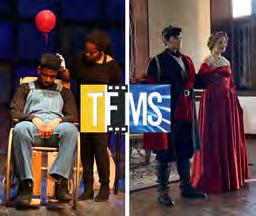
KCATCF, a national theater program, awarded two certificates of merit to the TFMS fall production of “Macbeth.” Assistant Professor of Scenography Leah Mazur and Assistant Professor of Theater Amy Steiger received one for production concept and execution, and Visiting Fight Choreographer Mallory Shear, received one for fight choreography. Additionally, students Jeremiah Pearl ’21, Joan Devonish ’22, Jeanette Warren ’20 and Nadia Gaylin ’22 were selected to audition for prestigious Irene Ryan scholarships during the festival. Warren and Gaylin auditioned with their scene partners, Sarah Butters ’20 and McKenna Johnson ’20. Warren and Butters were among 32 pairs to advance to the semi-finals.

Assistant Professor of Chemistry Troy Townsend ’07 had an article published in the Journal of Advanced Materials Interfaces about a radically new method of electroplating they call “electrostamping.” Traditional plating involves submerging parts in a coating bath, but this method is bathless and can form bright fluorescent metal films.
Dillon Waters ’20, a biology major, was recently awarded $1,020 from Cove Point National Heritage to support his St. Mary’s Project, in which he is researching more efficient ways to monitor changes in aquatic biodiversity in Maryland streams. Elizabeth Nutt Williams, professor of psychology, has a book chapter in the recently published “Bringing Psychotherapy to the Underserved: Challenges and Strategies” (Oxford University Press) by Jeffrey Zimmerman, Jeffrey E. Barnett, and Linda F. Campbell. Williams’ chapter explores current research strategies and considers additional, less often employed methodologies, in the area of mental health disparities.

St. Mary’s College of Maryland’s Black Student Union presented MK Asante on February 13 as the third Annual Elizabeth Barber Walker Lecture guest speaker. Asante is a best-selling author, award-winning filmmaker, recording artist, and distinguished professor. He is the author of “Buck: A Memoir,” which is a multi-year Washington Post bestseller and winner of numerous literary awards. “Buck” is currently being made into a major motion picture. The Elizabeth Barber Walker Lecture Series honors St. Mary’s College’s first Black graduate, Liz (Barber) Walker ’64. The Inaugural Elizabeth Barber Walker Lecture Series featured guest speaker April Ryan in 2018. Brittany Packnett was the 2019 guest speaker.
Three St. Mary’s College of Maryland faculty members were selected to participate in the U.S. Navy’s Summer Faculty Research Program at Naval Air Station Patuxent River (NAS Pax River). The awarded fellowships will fund Joshua M. Grossman, professor of physics and physics department chair; Charles Adler, professor of physics; and Daniel Chase, assistant professor of chemistry, during research at NAS Pax River in the summer of 2020. The 10-week program is run through the U.S. Navy Office of Naval Research.
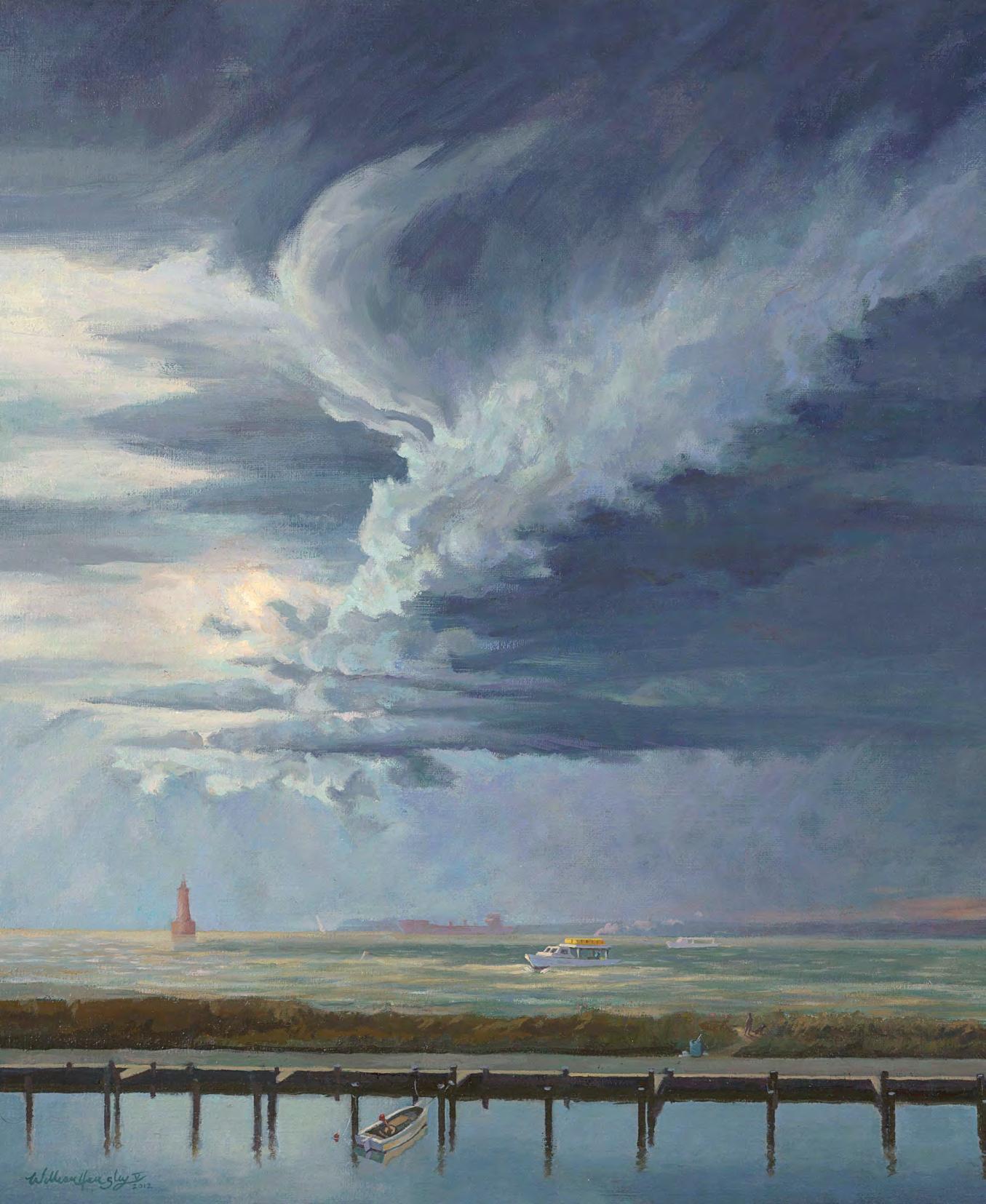
PHOTOS COURTESY OF ELIZABETH GRAVES
OIL & WATER WILL HEMSLEY WORKS IN BOTH MEDIUMS
BY LEE CAPRISTO, EDITOR
Will’s family on the Eastern Shore of Maryland dates
back to the War of Independence and includes the
settlers of Tilghman Island in the Chesapeake Bay
(Will’s full name, William Tilghman Hemsley V). He
grew up on Kent Island. His parents now live in the
house built by Will’s grandfather on Wye Island. With
his wife Stacy Hemsley and their three children, Will
lives in nearby Centreville, where he has his studio.
He hopes to install foundry equipment in the studio
so that he can pour his own bronze casts. During the
LEE CAPRISTO
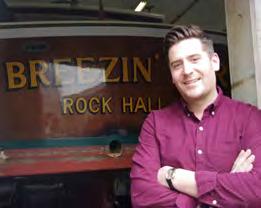
Will Hemsley with his boat, Breezin’ Thru, at the Rock Hall Railway Marina. left: “Storm off Bloody Point” oil painting on canvas.
COVID-19 pandemic,
he offered online live
streamed art classes
for both children and
adults.
Will transferred to St. Mary’s College after a year at Stevenson University. Will’s father, Tilghman Hemsley III, studied art at Pratt and then Maryland Institute College of Art. The waterman’s memorial sculpture on Kent Island, dedicated in 2003, was done by Tilghman Hemsley (with a teenaged Will helping on occasion). The idea for the “Fallen Star” memorial that has gained Will national attention was a vision that came to his father in a dream.
Will and his father are charter boat captains. His father started out as a mate to Captain Harry Carter onboard Breezin’ Thru, the boat Carter had built at Rock Hall in 1949. Carter signed the boat over to Tilghman Hemsley when he retired at age 87. As a child, Will and his brothers spent their free time running around the Rock Hall Railway Marina, where the boat was kept. “This was my playground when I was a kid,” he recalls. Will worked as a mate to his father at age 11 and became a licensed captain at 21. Together, they now run two boats and 500 charter trips per season from Rock Hall to Tilghman Island. They offer lunch and dinner cruises that include fishing for rockfish. Tilghman Hemsley is famous for sketching people’s portraits while the boats are docked.
“While it can be difficult from a logistics standpoint,” says Will, “I’ve been able to balance fishing and art pretty well. I love waking up before the sun and watching it crest over the island as the boat is pulling out of the marina. The experiences I get to share with clients and charter guests are great motivators for my work once I step off the boat.” Will’s medium is oil and his style American Realism. Many of his paintings adorn corporate offices and private homes. His painting is showcased in a wall mural at the Roy-Pitz Barrel House in Philadelphia, Pennsylvania, where he also created the brewery’s beer labels. The “Nice Dreams” label placed fifth in a nationwide beer label art contest in 2019. Just a few blocks from his studio in Centreville, Maryland, is a mural he painted on the outside wall of the American Legion Post 18. “Michelangelo said sculpting made him a better painter, and I think that’s true for me as well. Sculpting gives me the sense of three dimensions and that transfers into my painting.”



top: “Pier at Smith Island” oil painting on canvas. middle: “Fallen Star” sculpture commemorating Major General Harold Greene and fallen soldiers in the Afghanistan and Iraq wars jointly created by Will and his father, Tilghman Hemsley. bottom: Mural at the Roy-Pitz Barrel House in Philadelphia, Pennsylvania.
His first commission for sculpture was in Laurel, Maryland, for a four-story atrium in a business complex. “The client wanted bronze geese,” Will recounts. “Good thing I’ve been a hunter all my life; I pulled a goose out of my freezer to study its form.” Other commissions include a bronze sculpture, “Last Drop from the Stetson” to commemorate the 150 th anniversary of the Stetson Hat Company.
The “Fallen Star” sculpture was dedicated in September 2015 at Aberdeen Proving Ground office complex outside of Baltimore, Maryland. Jointly created by Will and his father, “Fallen Star” was dedicated to honor Major General Harold Greene and fallen warfighters of the Afghanistan and Iraq wars.
The Connecticut Fallen Star Memorial on the campus of Goodwin College in East Hartford, Connecticut, was dedicated on November 9, 2019. U.S. Rep. John Larson (D-1 st District) of Connecticut got the idea to have one for Connecticut after attending the dedication of “Fallen Star” at Aberdeen Proving Ground. The one in Connecticut is twice the size of the one at Aberdeen Proving Ground. Made of polished stainless steel, it weighs 6,000 pounds and reaches a height of 23 feet. It was trucked in pieces to the site and welded together there. Veterans on motorcycles escorted it to the site from the Connecticut state line. It honors the more than 30,000 fallen men and women of Connecticut from all wars from the War of Independence. Both installations include benches and three bronze figures, representing those who pay tribute to their loved ones at the memorial. A proposal for a similar memorial in Texas is under consideration as is a federal proposal to create a version for each state.
“I was overwhelmed by the effect the work had on the attendees at the unveiling on Veterans Day weekend,” Will remembers. “I stood and watched silently as people came in and embraced in front of the memorial, reflecting on loved ones no longer here. At the end of the ceremony, there was a couple waiting around until everyone left. When the venue was nearly empty, they approached me and hugged me and cried and wanted to show me pictures of their son who had died overseas. They had driven 3½ hours to attend the unveiling. The mother gave me a hand-painted American flag. I was pretty much reduced to tears and the impact of what good public art can be hit me in a way I had not yet experienced.”
“Turning Winds” for Greenleigh at Crossroads community in Middle River, Maryland, was dedicated on September 25, 2019. Made of brushed stainless steel and 20 feet tall, Will says, “I’m proud of the design – the shapes are derived from a leaf, yet when they are twisted and formed in the final product, the sculpture invokes different forms from different angles – as good contemporary sculpture should. My fabricator, Matt O’Connell, in Cambridge, Maryland, developed a great strategy for the oversized pieces. We even built our own machinery to allow us to roll the long sheets of stainless steel.” “I get an incredible rush when I move a contract off the table for a large-scale sculpture,” he admits. “Knowing that a client has entrusted me with a large project is very rewarding. Big projects involve many other people, and I’ve been able to develop a close circle of friends that are involved in all phases, so it’s exciting for all of us.” His ideal schedule is to have one big sculpture project per year with painting in between. “Painting is a stress reliever,” he says.

LEE CAPRISTO
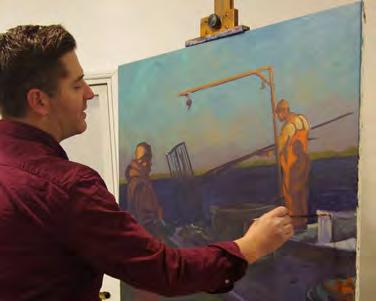
top: Fishing underneath the Chesapeake Bay Bridge on the Hemsley’s charter boat, Breezin’ Thru. above: Will at work in his studio.
His biggest inspiration for his work comes from his children. “Ten years ago, discovering I was to be a father, provided a degree of urgency that made me work harder and longer to seek the success that would provide stability for my family. The arts are not the easiest path to pursue, but I committed to being workman-like about it. I view it as a trade that demands long hours, proper marketing and relationship building. On another level, watching my three children paint and sculpt clay reminds me of how I was influenced as a child, sketching comic books on the floor of my father’s studio while he painted.” As for advice to aspiring artists, Will offers this: “If you are considering a career in the arts or are committed to that pursuit you should focus on that alone. The reality is if you are doing something unrelated during the day to pay the bills, you are going to have a hard time finding the energy to put in the thousands of hours required to be proficient in your chosen medium. Above all else, now that you have been trained and your head is bursting with theory and history and so-on, now you must start to unlearn the complex theories and remove the voices of your peers that linger in your head as you paint or draw. Try to get to the essence of why you chose this pursuit to begin with. If you are sincere and genuine in your craft it will show and it will resonate.”
And resonate it does. Will Hemsley’s art is a “Top 20 to Collect in 2020” according to Fine Art Connoisseur magazine.
JCB is Cherry Award Pick for Great Teaching

BY OLIVIA SOTHORON ’22, English major and Professional Fellowship Program intern in the Office of Integrated Marketing
Growing up with two parents who have PhDs in Renaissance literature caused Jennifer Cognard- Black to try and pursue a different career path, given that children often balk at following in their parents’ footsteps. As a double major in both English and music – with a specialization in piano
– Cognard-Black graduated with a BA from Nebraska Wesleyan University with the decision to take gradu
ate courses at Iowa State University in student affairs administration, while working as an accompanist on the
side. Enjoying her position as resident assistant during her senior year of college pushed her in the direction
of becoming either a future director of residence fife or a vice president for student affairs. Once she started on
the coursework, however, Cognard-Black found that she did not like it, apart from the one English class she
had signed up for each semester “just for fun.” Soon, Cognard-Black was indeed following in the footsteps of
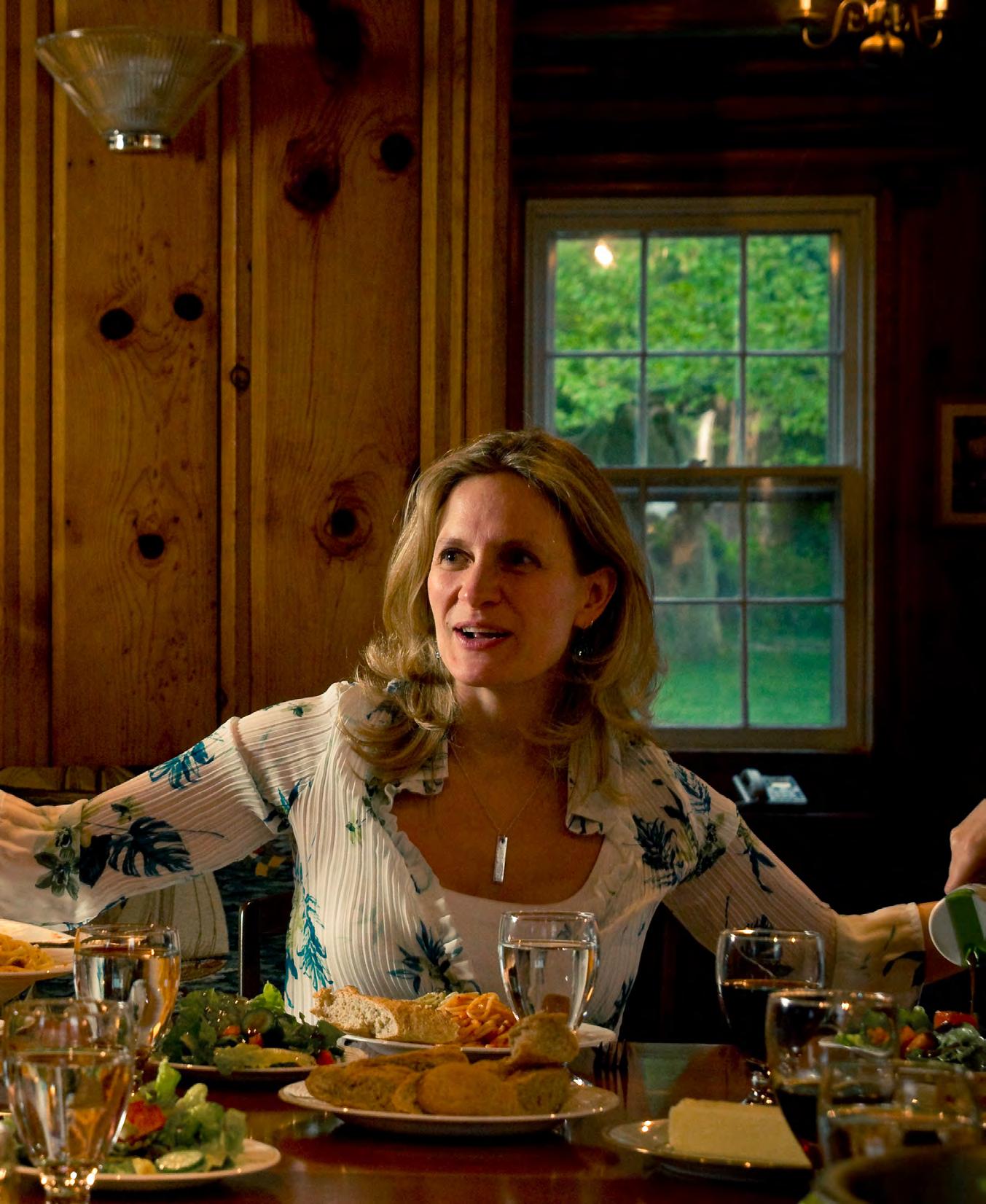
her parents, pursuing a master’s degree in English.
RECOGNIZING AN EXCEPTIONAL EDUCATOR: “You know from the first moment you walk into her class that she expects a lot from you, but she’s also going to give you 110% back...Even characteristically lazy students will ‘do it for her.’ Because of course you do. Because when you walk in that room with her, you are seen. You are valued.” Katelyn Mattingly ’16 (now a teacher in Austin, Texas)
NO ORDINARY CLASS: “Watching her work was not like watching a martyr, but rather like jumping onto a moving train and experiencing the speed and thrill of her ongoing adventures.” Toby Wilson-Bates ’06 (now an assistant professor of English at Georgia Gwinnett College)
WORKING WITH AN EXEMPLARY TEACHER: “She seemed to treat every student paper as if she were a professional copy editor and the two of you were working on publishing something. I cannot imagine how much time and energy she has invested in marking papers.” Toby Wilson-Bates
JCB AND THE ST. MARY’S EXPERIENCE: “I was lucky to have many smart, invested, and enthusiastic professors at St. Mary’s College, but in JCB’s classes, I knew I was also going to have fun. We were going to be joyful and laugh while we learned.” Stacey Hamlet ’05 (editor for LexisNexis and now for ProQuest)
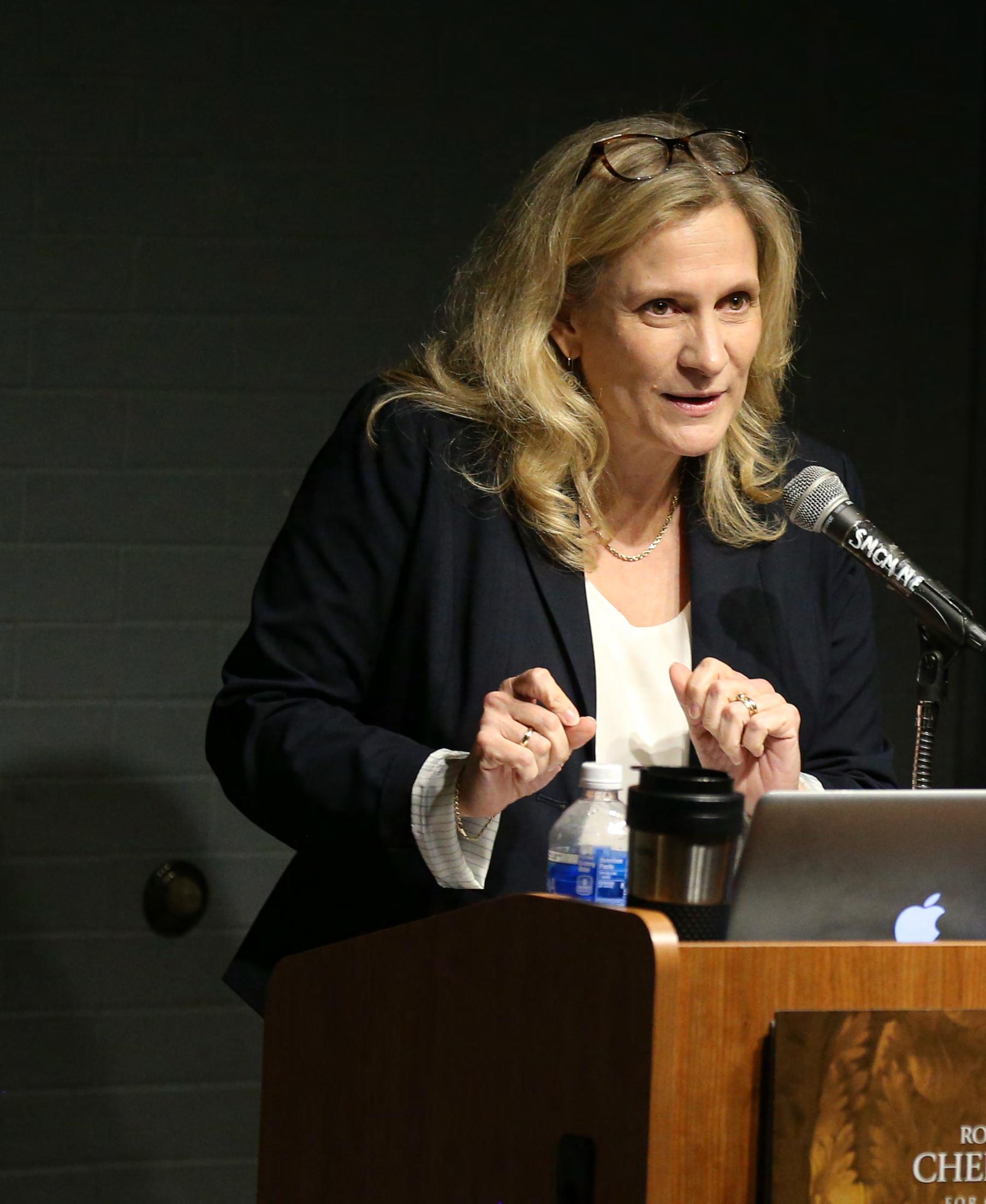
FAVORITE COURSE: Creative Writing course with JCB in Slovenia – “This course was my first contact with the world of creative writing and I absolutely loved it. It changed how I wrote my own pieces and also how I read literature, how I thought about it, how I understood it.” Estera Deželak (JCB’s student at the University of Ljubljana during her first Fulbright in 2012, then a Slovene exchange student at SMCM who now works as a translator)
JCB’S LONG-LASTING LEGACY: “She shaped my time at St. Mary’s in the best possible ways: offering interesting courses and discussion, gently pushing me to become a better thinker and writer, and supplying her guidance and friendship in the years following graduation.” Stacey Hamlet
LINGERING MEMORIES: “More than having a favorite memory, I remember how she would articulate the main topic at hand, the gestures she used, her body language. She would stand rather than sit, she would move around and draw the whole classroom into the center of the action.” Estera Deželak
“I found myself living for my lit classes,” remarked Cognard-Black. During her first year of graduate school, Cognard-Black took a course on American Comedy with Jane Smiley, who won the Pulitzer Prize for fiction in 1992 for her novel based on Shakespeare’s “King Lear,” entitled “A Thousand Acres.” “I was so smitten by her seminar,” Cognard-Black explained, “that I decided to pursue a master’s in creative writing under her tutelage, and so I sidled over from student affairs to English and completed my degree in creative writing at [Iowa State University].”
After graduating from Iowa State, CognardBlack spent the next six years pursuing a PhD in Anglo-American literature by women writers of the nineteenth century and feminist literary theory at The Ohio State University. “I loved reading, writing, and thinking about books, and so graduate school was the right fit for me, and I guess I felt I was still ‘rebelling’ against my parents (at least a little) because I was a Victorianist and a creative writer, not a Shakespearean scholar!”
Two weeks after presenting her dissertation, Cognard-Black gave birth to her daughter Katharine, and began looking for a job. “I applied that fall to 88 college teaching jobs in literature, women’s studies, rhetoric, creative writing, and writing program administration, with the hopes that I could land something in order to feed and clothe our newborn baby,” she explained. Fortunately enough, for both Cognard-Black and St. Mary’s College of Maryland, an opportunity presented itself at the small liberal arts college in Southern Maryland.
“Honestly,” Cognard-Black stated, “I was terrified to teach full time. I didn’t think I’d be very good at it – certainly not as good as my own parents.” However, ever since Cognard-Black began her career at St. Mary’s College, she has not once regretted following in the footsteps of her parents as educators. “Literature and writing opens minds – as well as hearts,” she said. While providing the St. Mary’s College English Department with a strong addition, Cognard
“I was raised in the ‘Church of Shakespeare.’” Jennifer Cognard-Black
Black’s position as an educator has also allowed her to better develop her personal teaching philosophy, which is to “never underestimate what your students can achieve, but as you hold the bar high for them, do everything in your power to help them reach it.”
Throughout her twenty years at St. Mary’s College, Cognard-Black has done just that. She holds high expectations of her students, but does everything in her power to help them to reach those objectives. Across these two decades, Cognard-Black has advised 46 St. Mary’s Projects, held two Fulbright Scholarships, published five books, and inspired many. Her love for her work and her dedication to her students is prominent both within and outside of her classroom.
While at St. Mary’s College, Cognard-Black has held many administrative positions as well, including serving as chair for the English Department (2018-2020) and coordinator of the Women, Gender, and Sexuality Studies program (2007- 2011), and also directing the VOICES Reading Series (2014-2015). As the English Department Chair, Cognard-Black explained that “you must be a strong advocate – a powerful voice – for your departmental colleagues as well as your majors and minors…[;] being Department Chair was simultaneously the most challenging job I’ve held, as well as the most rewarding.”
Yet Cognard-Black further noted that it is her time in the classroom that has defined her career more than shaping curricula, hosting events, or supporting colleagues. “[The students] are the beating heart of St. Mary’s, and the reason all of us who teach here continue to love our jobs.” Her work as an educator has inspired many of her students to become educators themselves, carrying her enthusiasm and love of writing and reading into their own classrooms.
One of the most well-known courses on campus is Cognard-Black’s “Books that Cook” English topics class, which analyzes how recipe narratives present food for various rhetorical aims. This topic emerged while in graduate school with one of Cognard-Black’s “long-time collaborators and friends,” Dr. Melissa Goldthwaite. Cognard-Black explained that, as graduate students, she and Goldthwaite swapped food novels back and forth, sometimes cooking the meals mentioned in the novels. After earning their doctorates, they both implemented their own versions of the “Books that Cook” seminar at their respective universities – Goldthwaite’s focused more on poetry and essays at Saint Joseph’s University, while Cognard-Black’s is more focused on fiction and film. The two educators, recognizing the lack of textbooks for food literature classes, developed their own, bringing “Books that Cook: The Making of a Literary Meal” into being in 2014 with New York University Press. This collection includes poetry, short fiction, and essays that all include recipes, and it runs the gamut of contributors, from those with national recognition (such as Maya Angelou, Sherman Alexie, Nora Ephron) to those who are members of the St. Mary’s community, including poems by Karen Leona Anderson and Michael Glaser, as well as two additional works by Caitlin Newcomer ’05 and Cheryl Quimba ’05.
As someone whose cooking and baking is well-known to anyone who has had the opportunity to take a class with her, Cognard-Black’s relationship with food has been deepened by her research and understanding of how food literature impacts readers. “I now understand [food] as something much more potent than mere sustenance or enjoyment,” she mentioned. “Food is identity. It’s ritual, religion, history, family, community, memory, politics, justice, economy, entertainment, commodity, and the most important environmental resource we have other than water and sunlight.” She has also become more aware of the need to ensure humanity’s access to healthy food, explaining that plentiful food is a “fundamental right of everyone on the planet – not just those who have the monetary means to procure it.” It is for this reason that CognardBlack encourages her “Books that Cook” students to take part in service-learning projects for social change to ensure that all people have access to nourishing food.
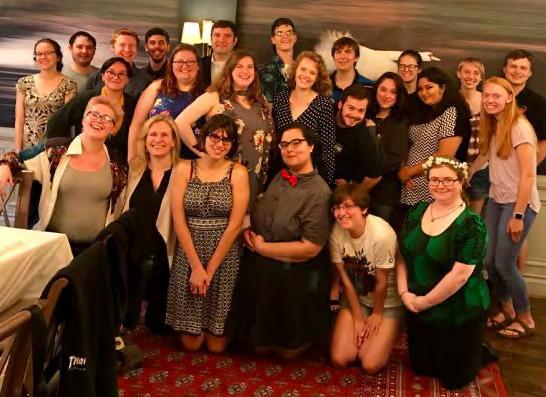
above: Jennifer Cognard-Black poses with her students during the 2019 Shakespeare summer study tour to Stratfordupon-Avon. opposite: Students taking Jennifer CognardBlack’s “Books that Cook” course prepare and enjoy a meal together at the May Russell Lodge.
Cognard-Black’s dedication to studying food literature and how it influences readers has been broadened on her numerous trips abroad, allowing her to explore the roles of food across different cultures. Over the years, CognardBlack has taught abroad in Stratford-upon-Avon, England; Alba, Italy; Ljubljana, Slovenia; and she was teaching in Amsterdam, the Netherlands in the spring of 2020 until Fulbright brought its scholars home due to the COVID-19 pandemic. “I often teach abroad because it puts me in the position of a student,” she noted. “My own knowledge broadens, and I am challenged…[;] that is what teaching really must be in order for it to remain both vibrant and vital: it must make the teacher a bit insecure, unsure of how things will go, of whether this approach or exercise or discussion or assignment will work well or be a failure.” Even in her classes on the St. Mary’s College campus, Cognard-Black brings the perspective of cultures outside Anglo-America into her lessons, reminding her students that it is important to consider global perspectives, which are often different from their own.
Aside from teaching, Cognard-Black’s publications – from short fiction, to essays, to critical analyses, to anthologies and a writing textbook–have also allowed her to expand her understanding of the world around herself. “I write to learn, I write to know, and I write to understand,” she explained. “I cannot imagine my existence without reworking it through words, for I agree with Anaïs Nin that ‘we write to taste life twice.’” Currently, Cognard Black is working on crafting a second volume of food writing with Goldthwaite, this time focusing on the genre of ethical eating essays, tentatively entitled “Just Food: Perspectives on Ethical Eating.” She hopes that this anthology will be international, reflecting writers outside of the United States as well as from within. “It’s my hope that it will include a piece or two by Dutch authors, possibly one of my own students,” she remarked. CognardBlack is also currently working on her first novel, “fictionalizing part of the actual, lived life of novelist Edith Wharton,” who was the first woman to win the Pulitzer Prize for fiction.
As a result of being the recipient of the 2020 Cherry Award for Great Teaching, CognardBlack will spend the fall 2020 semester teaching at Baylor University in Waco, Texas, where she will teach both sophomore-level as well as senior-level undergraduate students in addition to helping to advise senior projects and master’s theses. After spending the fall at Baylor University, Cognard-Black will take a sabbatical in the spring of 2021. Her absence will be greatly missed around the St. Mary’s College campus, but her colleagues and students are also excited for the phenomenal opportunities that lie ahead for her.

Jennifer Cognard-Black
THE ARTIST HOUSE BUILT FOR FOSTERING CREATIVITY
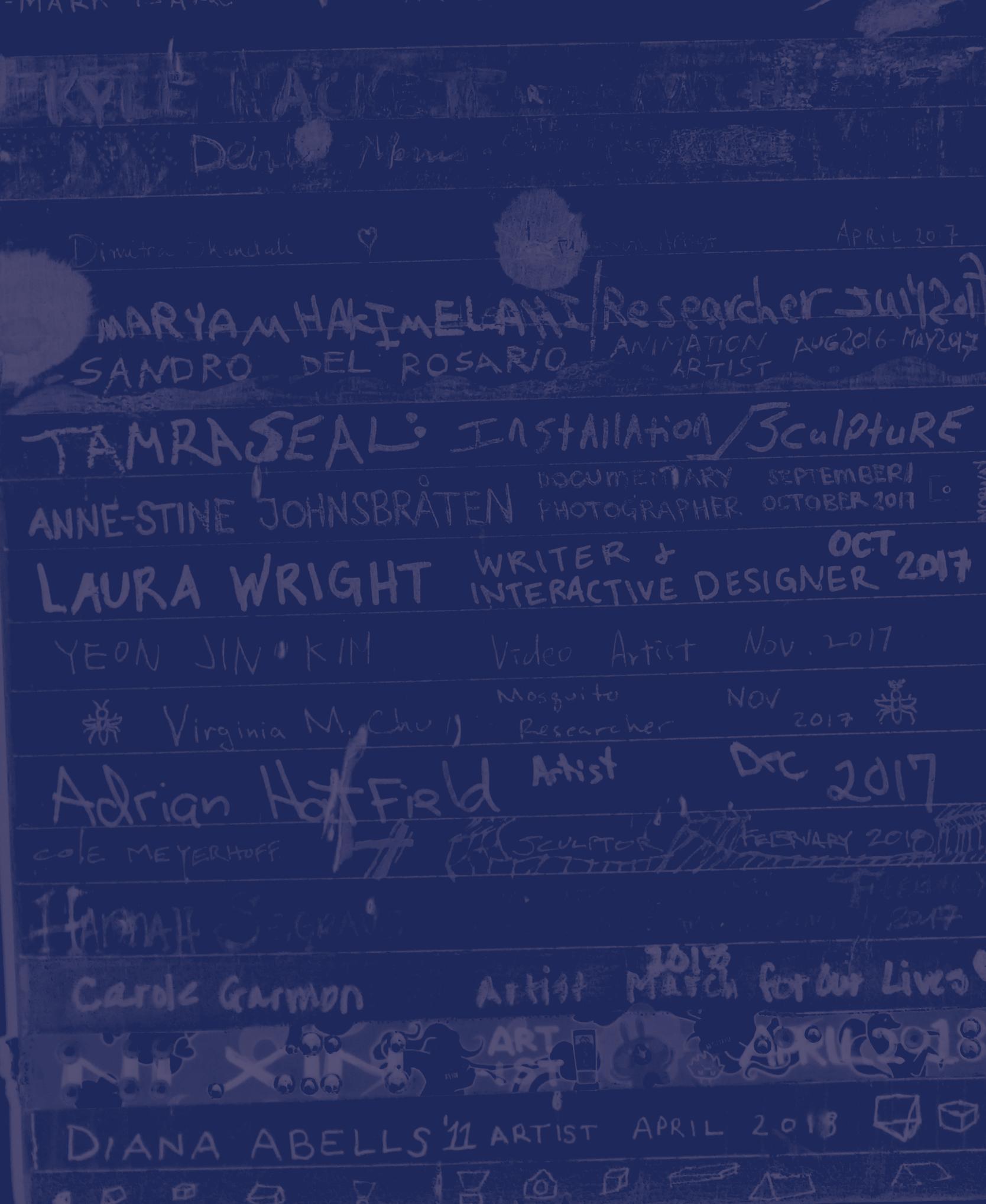
PHOTOS BY LEE CAPRISTO
Established in 2003 by co-founders Professors Sue Johnson and Michael Glaser, the Artist House at St. Mary’s College of Maryland continues its mission to support the arts by serving as a residency program to regional, national and international arts professionals and practitioners: visual artists, art historians, critics, curators, scholars and writers and poets. The resident artists get time and space to create new work; the campus and broader community benefit from planned programming and workshops given by the artist during their residency.
During the fall of 2019, the Artist House served as a temporary home to four artists: Dorotha Grace Lemeh (artist, poet and educator); Clare Nicholls ’10 (weaver, artist and educator); Miriam Schaer (abstract artist, educator and writer); and Valerie Hardy (painter and educator).
Dorotha Grace Lemeh’s residency took place from Sept. 9 through Oct. 5. As a visual storyteller, Lemeh conveys the message of the underestimated strength of women through the use of female figures – often her own – and powerful quotes. Her work has been featured in museums and exhibitions around the world. Lemeh’s main intentions with her work are to tell her own story and to help young women feel empowered. “I want to have strong, powerful, beautiful images of women,” she explained.
During her stay at St. Mary’s College, Lemeh most enjoyed being able to focus solely on her art, for she seldom can while teaching at Wilkes Honors College in Jupiter, Florida. She also appreciated the opportunity to deliver lectures to various classes and student groups. Additionally, Lemeh conducted studio visits with art students completing their St. Mary’s Projects in art, providing insight and feedback to the students on their works in progress.
Two of the “guest logs” made of wood and hanging on the walls in the Artist House, where visiting artists record their stay with a creative flourish.


Clare Nicholls ’10 majored in art, and currently lives and works in Baltimore, Maryland. It was during graduate study at Maryland Institute College of Art that her interest in fabrics and weaving developed. “Something about the process of turning the warp made a switch flip in my head that was like, ‘this is it,’” she stated.
During her time in the Artist House, Nicholls focused her attention on a piece that will eventually be developed into a book made entirely out of her weavings. The pages of the book are made from the weavings she completed herself by a technique known as “double-cloth.” The book will feature ten poems written by Nicholls, and each letter is woven into the product to create a fascinating work of colors and words.
She remarked that it felt great to return to campus because she continued to feel the support of the faculty members who helped develop her into the artist she has become. “When I was here as an art student, I went to the artist talks by visiting artists, so it was so nice to be back and to participate in this thing I experienced on the other side,” Nicholls explained.
Miriam Schaer, a Brooklyn-based interdisciplinary artist who focuses her attention on the exploration of feminine, social and spiritual issues, spent two weeks at the Artist House. She uses books, garments, photography, installation and collage to pursue these truths. At the Philadelphia College of Art – which is now the Philadelphia University of the Arts – Schaer majored in fibers and took a book arts class in the printmaking department. The class exposed her to the process of making a book, which she says “really spoke to me!”
On Saturday, Nov. 10, Schaer led a workshop at SMCM co-sponsored by the Arts Alliance to promote the beauty of bookbinding and excite
others about a technique with which she feels a strong connection. Each participant had the opportunity to follow along with Schaer as she led them through the process of creating a book, leaving them with their own personalized finished book. Delilah Parks ’20, who made her own book during the workshop, said “Miriam Schaer spent a lot of time with the class in addition to her workshop, sharing what book-making meant to her and how it could influence our lives in meaningful ways. Book-making is a special skill to have, not only for making art, but as a time for self-reflection and creating a way to document.”
Valerie Hardy served as the Artist House Teaching Fellow, a full semester residency that also comes with the opportunity to teach an art class and participate in the life of the Art and Art History Department. She has been a painter “from life” as she describes herself for 45 years and has experi- ence teaching painting at the college level. Upon her arrival on campus, she re-entered the teaching field after a 15-year retirement. Hardy spent the fall 2019 semester teaching ART 206: Introduction to Painting to a class of students with little to no art experience.
Teaching a class at SMCM while also creating new works in the Artist House studio, Hardy finds that as she instructs, she is able to better her- self as both an artist and as a professor. “I like to think that what I do affects their work,” she stated. Hardy emphasized to her class the importance of training the eye to observe how light impacts and alters one’s perception of an artwork. She also encouraged her students to become more com- fortable with constructive criticism and feedback on works in progress. The critique in art is “just a part of learning,” expressed Hardy, and it allows her students to better comprehend the language of art.
left: Clare Nicholls ’10 shows a detail of one of her poems, hand-drawn into a pattern for weaving. middle: Stitching signatures together during Miriam Schaer’s bookmaking workshop. bottom: Carol Morris ’20 (left) and an Arts Alliance member working on their books during the workshop.

Several artists were scheduled to take part in the residency program during the spring semester, but just two were able to come before the COVID-19 crisis closed the campus: art critic and curator Saul Ostrow and conceptual artist Michelle Kohler ’01.
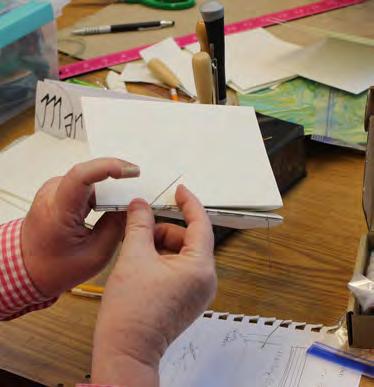
SMCM’s Artist House Residency Program offers the opportunity for artists at all stages in their ca- reers to set aside their everyday lives and dedicate time to concentrate solely on their creative and scholarly work. Program Director and Profes- sor of Art Sue Johnson explains “it’s a two-way street – the residents are given the time and space to focus on their work and in return each resident engages with the SMCM community in diverse ways through arts programming, class visits, lectures, workshops and informally meeting with students, faculty, staff and community members.” Johnson adds that the visiting artists “also serve to demystify the creative and scholarly process. Our students are able to interact with the residents and gain their insight and advice for the future.”

The Artist House also hosts a program known as CoLab, in which an SMCM faculty member can invite their research or collaborative partner for a residency to facilitate their collaborative projects. Throughout its time, the Artist House has served as a home to diverse artists, art historians, critics and curators, scientists and scholars across many disciplines, and there are sure to be more artists to visit in the future.


